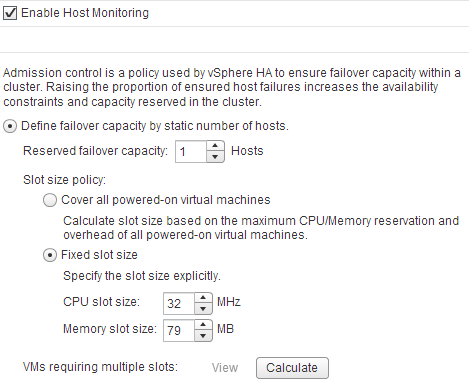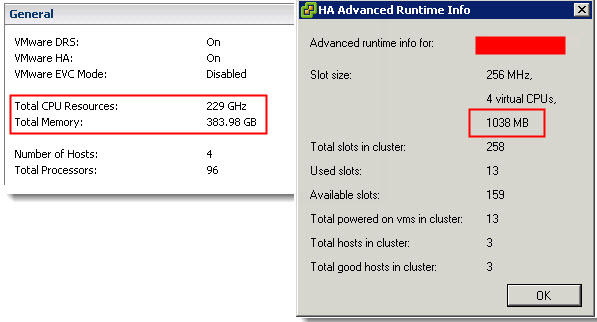Vmware Cluster Slot Size Calculation


In part 1 of the series of post on the impact of oversized virtual machines NUMA architecture, memory overhead reservation and share levels are reviewed, part 2 zooms in of the impact of memory overhead reservation and share levels on HA and DRS.
Impact of memory overhead reservation on HA Slot size
The VMware High Availability admission control policy “Host failures cluster tolerates” calculates a slot size to determine the maximum amount of virtual machines active in the cluster without violating failover capacity. This admission control policy determines the HA cluster slot size by calculating the largest CPU reservation, largest memory reservation plus it’s memory overhead reservation. If the virtual machine with the largest reservation (which could be an appropriate sized reservation) is oversized, its memory overhead reservation still can substantial impact the slot size.
The HA admission control policy “Percentage of Cluster Resources Reserved” calculate the memory component of its mechanism by summing the reservation plus the memory overhead of each virtual machine. Therefore allowing the memory overhead reservation to even have a bigger impact on admission control than the calculation done by the “Host Failures cluster tolerates” policy.
DRS initial placement
DRS will use a worst-case scenario during initial placement. Because DRS cannot determine resource demand of the virtual machine that is not running, DRS assumes that both the memory demand and CPU demand is equal to its configured size. By oversizing virtual machines it will decrease the options in finding a suitable host for the virtual machine. If DRS cannot guarantee the full 100% of the resources provisioned for this virtual machine can be used it will vMotion virtual machines away so that it can power on this single virtual machine. In case there are not enough resources available DRS will not allow the virtual machine to be powered on.
Shares and resource pools
When placing a virtual machine inside a resource pool, its shares will be relative to the other virtual machines (and resource pools) inside the pool. Shares are relative to all the other components sharing the same parent; easier way to put it is to call it sibling share level. Therefore the numeric share values are not directly comparable across pools because they are children of different parents.
By default a resource pool is configured with the same share amount equal to a 4 vCPU, 16GB virtual machine. As mentioned in part 1, shares are relative to the configured size of the virtual machine. Implicitly stating that size equals priority.
Now lets take a look again at the image above. The 3 virtual machines are reparented to the cluster root, next to resource pools 1 and 2. Suppose they are all 4 vCPU 16GB machines, their share values are interpreted in the context of the root pool and they will receive the same priority as resource pool 1 and resource pool2. This is not only wrong, but also dangerous in a denial-of-service sense — a virtual machine running on the same level as resource pools can suddenly find itself entitled to nearly all cluster resources.
Because of default share distribution process we always recommend to avoid placing virtual machines on the same level of resource pools. Unfortunately it might happen that a virtual machine is reparented to cluster root level when manually migrating a virtual machine using the GUI. The current workflow defaults to cluster root level instead of using its current resource pool. Because of this it’s recommended to increase the number of shares of the resource pool to reflect its priority level. More info about shares on resource pools can be found in Duncan’s post on yellow-bricks.com.
Go to Part 3: Impact of oversized virtual machine.
Dec 07, 2018 A High Availability (HA) slot size calculation becomes distorted when using VMware strict admission control The cluster summary displays a message ' Insufficient configured resources to satisfy the desired vSphere HA failover level on the cluster '. Slot size is an important concept because it affects admission control. A VMware ESXi cluster needs a way to determine how many resources need to be available in the event of a host failure. This slot calculation gives the cluster a way to reserve the right amount of resources. The slot has two parts, the CPU component and the memory component. Each of them has its own calculation. If there are no virtual machine resource reservations in the cluster, then the slot size (for ESXi 5 at least) is 32 Mhz for CPU and 0 MBs + overhead for memory. (I’ve used 80 MBs as my memory overhead in the examples).

Vmware Cluster Slot Size Calculation Calculator

Vmware Cluster Slot Size Calculation Tool
Welcome to the latest version of my cluster calculator! You can type in the field of the online table and the online table will calculate how many hosts you need. You can make the calculation for 2 different setups side by side. Take note that all values in black are VARIABLES (About 20 variables can be adjusted). Changing any of them will change the recommendations in the top and throughout.